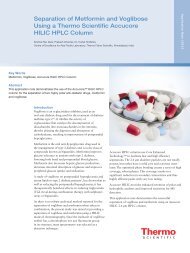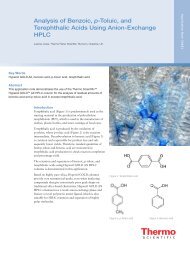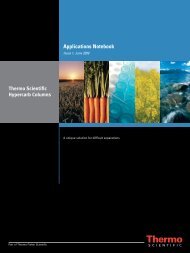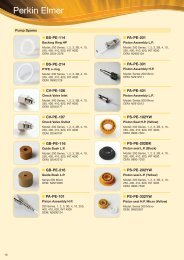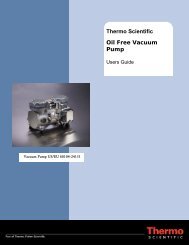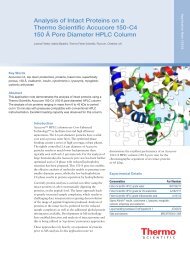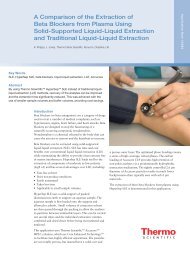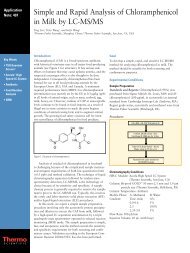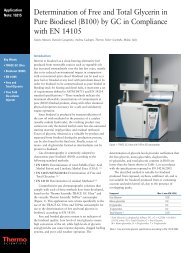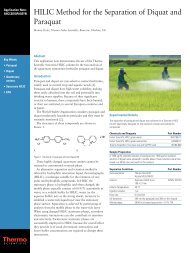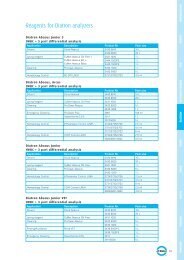Chemical Reference Standards AccuStandard®
Chemical Reference Standards AccuStandard®
Chemical Reference Standards AccuStandard®
Create successful ePaper yourself
Turn your PDF publications into a flip-book with our unique Google optimized e-Paper software.
PCBs<br />
AccuStandard is known throughout the world as the only source for all 209 PCB congeners.<br />
PCB <strong>Standards</strong> are listed as follows:<br />
Neats and Single Solutions<br />
International Methods<br />
Selected USEPA and Other Mixtures<br />
Metabolites and Derivatives<br />
Aroclors<br />
USEPA Methods:<br />
AccuStandard offers many more mixes, which can be found on our website, or in our other catalogs, including products for USEPA Methods:<br />
PCBs<br />
EPA Method PCB Methods<br />
505 Organohalide Pesticides & Aroclors (ECD)<br />
508 & 508.A Chlorinated Pesticides & Aroclors (ECD)<br />
525.1 Semi-Volatiles, Congeners, Chlorinated Pesticides (GC/MS)<br />
625 BN/A Semivolatiles, Pesticides, Aroclors (GC/MS)<br />
680 Pesticides & PCB Congeners (GC/MS)<br />
1668 209 PCB Congeners (GC)<br />
8082 PCBs (ECD)<br />
Many more related products available!!!<br />
See our EPA Method Supplement or<br />
www.accustandard.com for the complete<br />
line organized by USEPA Method number.<br />
Synthesis capabilities are what sets AccuStandard above the rest. AccuStandard employs experienced PhD chemists with many years of academic<br />
and industrial experience. These chemists can synthesize chemicals of high purity to be used as reference standards. If you do not see the<br />
compound you are looking for, contact us by phone or e-mail at techservice@accustandard.com to see if we can synthesize the material for you.<br />
Custom mixtures can be formulated to meet your individual needs. If you do not see what you are looking for, we will help you design the product<br />
that will best suit your requirements.<br />
Historical Perspective<br />
Polychlorinated biphenyls (PCBs) have been the subject of numerous<br />
studies and investigations over the last several decades because of<br />
their enviromental persistency and bioaccumulation.<br />
Their abundance as a pollutant stems from their worldwide<br />
manufacture as heavily-used industrial chemicals (in the USA, as<br />
Aroclors by Monsanto), with the main application as a di-electric fluid<br />
for capacitors and transformers. As late as 1984, about 758 million<br />
pounds were still in use in the United States alone.<br />
Toxicity & BioAccumulation<br />
The chemical formulation of PCBs, its physiological properties<br />
(liphophilicity causing bioaccumulation in body lipids and liver organs)<br />
and overall toxicity are quite similar to that of the banned pesticide,<br />
DDT.<br />
One of the first signals of the effect of PCBs on the environment, in the<br />
United States, was noted in 1970 on Great Gull Island at the entrance<br />
to Long Island Sound. Scientists observed a sharp increase in the<br />
number of abnormalities found in young sea gulls, such as feather loss,<br />
crossed beaks, and four legs. In addition, the egg shells were<br />
extremely thin.<br />
In 1968, Japan documented the first of over 1200 human patients,<br />
many of them children, who developed acneform skin eruptions<br />
(chloracne) and other clinical symptoms. These symptoms were<br />
eventually traced to the ingestion of the industrial PCB, Kannechlor<br />
400, (trademark of the Kanegafuchi <strong>Chemical</strong> Industry Company)<br />
which had been blended with Rice Oil (Yusho).<br />
The effect was thus termed Yusho Disease. The average amount of<br />
actual PCBs consumed by the victims was estimated at 2 grams. By<br />
1973, 22 of the 1200 victims had died, 41% from malignant tumors,<br />
suggesting a possible excess mortality from that cause.<br />
Since then, additional studies have been performed discovering many<br />
more occurrences and correlations.<br />
Regulatory Actions<br />
The overwhelming problem with PCBs is their continuing environmental<br />
impact. Their stability, and widespread prior use, has caused global<br />
contamination of soils, rivers and other waterways that could affect our<br />
food and water supplies for years to come.<br />
This problem has become of paramount concern to the US EPA, which<br />
prohibited, under Section 6(e) of the Toxic Substances Control Act, the<br />
use of PCBs, except in totally enclosed systems, after July 1, 1978; the<br />
manufacture of PCBs, after January 1, 1979 and the processing and<br />
distribution in commerce of PCBs after July 1, 1979. PCBs use as<br />
industrial chemicals were totally prohibited after July 1, 1984.<br />
In order to facilitate environmental monitoring, toxicity studies, and<br />
possible destruction of PCBs present in the environment, the EPA<br />
permits the synthesis and distribution of small quantities for research<br />
purposes.<br />
In the course of the investigations, it was determined that some of the<br />
209 congeners that constitute the industrial PCB product behave<br />
differently than others and it is very helpful, even essential, to the<br />
scientific and regulatory communities, that individual congeners be<br />
available. For this reason, the EPA granted manufacturing and export<br />
exemptions to a few, select standards manufacturers.<br />
The founder of AccuStandard, Inc. was the first to<br />
obtain this exemption. AccuStandard is the leader in<br />
synthesizing those chemicals and indeed, is the first,<br />
and so far only, manufacturer to have made all 209<br />
congeners. Our expertise can assist you in your PCB<br />
investigations.<br />
For MSDSs visit our website at www.AccuStandard.com 1



